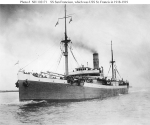Propulsion: Three single ended boilers, one 2,250hp verticle triple expansion steam engine, one shaft.
Click on thumbnail
for full size image |
Size |
Image Description |
Source |
 |
96k |
Photographed prior to her World War I Naval Service
U.S. Navy photo NH 102171 |
Naval Historical Center |
 |
107k |
In port, circa 1917
Naval Historical Center photo NH 105602 |
Robert Hurst |
Commanding Officers
|
| 01 | LCDR Niles J. Okland, USN | 1918 |
Dictionary of American Naval Fighting Ships: Saint Francis, a steel-hulled screw freighter built in 1914 by the North Ireland Ship Building Co., Londonderry, Ireland, was acquired by the Navy at Baltimore on 19 June 1918 under United States Shipping Board (USSB) charter from the United States Steel Products Co.; and commissioned there on 25 June.Assigned to the Naval Overseas Transportation Service, the ship was loaded with Army supplies and sailed for New York where she joined a convoy and sailed for France on 4 July. The ships reached Brest on the 19th; and, the next day, Saint Francis proceeded to West Hampton, England, where she discharged her cargo. On 15 August, she sailed in convoy for the United States and reached Baltimore on the 27th. Reloaded with Army supplies, she again got underway on 18 September and steamed via New York to France and arrived at La Pallice on 13 October. The next day she proceeded to Saint Nazaire where
she unloaded.
Back in Baltimore on 14 November, three days after the armistice was signed, the ship was transferred from an Army to a USSB Account and sailed from New York on 26 January 1919 for Cristobal, Panama. After transiting the canal, she proceeded down the Pacific coast of South America and reached Valparaiso, Chile, on 17 February. After returning through the canal, the ship loaded a commercial cargo of sugar at Cienfuegos, Cuba, and arrived at New York on 8 April. She was decommissioned there on 28 April 1919 and the same day was transferred to the USSB for simultaneous return to her owner.
This page created by Joseph M. Radigan and maintained by David Wright

|